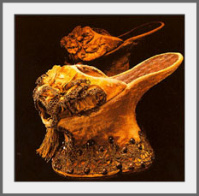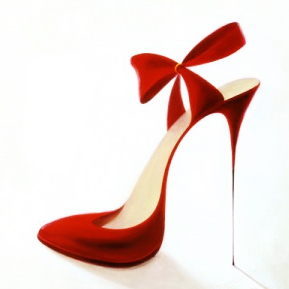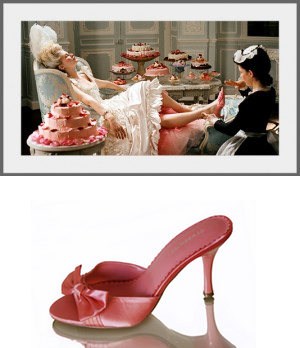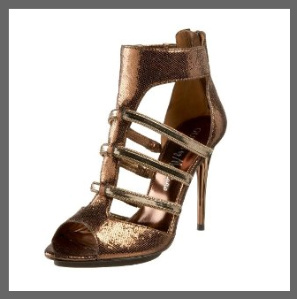Ancient Egyptian murals depict leather pieces held together and the style was that of the Ankh, which represents life or an era Prince went through. Both men and women wore heels and it was a sign of caste—and usually worn for special occasions. Some things never change…men are still trying to get into our shoes (you thought I was going to say something else, didn’t you?!).
Ancient Greece and Rome Bring in the Platform Peep Toe Shoes Era
Ancient Greece and Rome brought in platform peep toes and platform sandals (called kothorni and then buskins during the Renaissance era). The platform shoes had high wood or cork soles and again were caste conscious, as different heel heights represented varying social standing. Either you were high class or you were a butcher, as the butchers wore platform high heels to walk over all the blood and guts…ewwwe.

Chopines
1400s Platform Shoes Still Working It
Platform Shoes are still popular and are called chopines (wonder when Chopin was popular, wonder if that has anything to do with him and tapping of the feet, wonder…sorry) with a heel that ranged from seven inches to 30 inches. And, you think we have it tough learning to walk seductively—these women had to use canes or servants to enable them to walk. Just goes to show you beauty knows no bounds.
The Venetian Snobs
The Venetians upped the ante and made the chopine a status symbol representing wealth and social standing for women—as if needing a servant to walk didn’t show your wealth and social standing—that is if you could stand at all in the 30 inch heel. Do you think this is was the inception of the invention of stilt walking?
1500s
Catherine de Medici was a small woman (not quite five feet), she was also considered to be quite plain. On the other hand, her husband, had a tall mistress. One day, de Medici decided to take action and rebel against her drab, wallflower looks. She wore high heels—Catherine put on really tall high heels; the confidence the heels gave her made the platform shoes an immediate hit and she rose high in society standing. Plus, she became known for the alluring sway of her butte. It is said, the mistress slept alone that night (this could be the reason we say Irene Dunne F— Me Shoes).
1580
High Heels were, once again, popular for men and women. Their allure keeps pulling those men over, doesn’t it?! This seems to be an ongoing theme throughout history, doesn’t it?!
1700s, Red High Heels are the Bomb and High Heels Only for the Elitists’
France’s King Louis XIV wore two to five inch heels decorated with battle scenes. Called, what else, Louis Heels, of course he is going to take credit for inventing high heels. He reminds me of some of our present day ‘law makers’ in more ways than one! Also, he deemed no one could wear heels higher than him and the color red was to be reserved for aristocrats high heel shoes only.
1793 Another Long-Standing Trend Began; The Napoleon Complex
The Napoleon Complex now becomes clear, as Napoleon banished high heels in an attempt to show equality. What man in his right mind would do that? Even my gay friends love high heels; sometimes they try to wear mine. Yet, Marie Antoinette was determined to look good right to the very end. She defied Napoleon’s order and wore her high heels right to the end of her life, even to her execution. What was he going to do her for disregarding his rule? Have her beheaded again?
After Napoleon’s order, the height of the high heel kept going down, eventually the heel became a spring heel—which was one single layer of leather for the heel. It was here; the inspiration for the hot gladiator shoe got its beginning, for the low-heeled shoe was worn with ribbons criss-crossed and tied around the ankle. Well, it seems they were copying the early Roman style.
 Witchy Woman – Eagles |
1800s High Heels Bewitching
The Puritans in the Massachusetts Colony declared it against the law for women the wear high heels. They felt the sexuality of high heels bewitched the men…thus, a dark time for the high heels because of the witch trials. If a man became enamored of a woman when she was wearing high heels, the woman was immediately put on trial for suspicion of being a witch. One thinks it was here the song Witchy Woman was conceived, but the aren’t quite that old now, are they? |
Mid 1800s high heels finally become fashionable in the America’s. We finally loosened our pucker strings a bit and decided women could look a little more alluring.
Major influences brought the high heel into well-heeled fashion, such as; Ginger Rogers—and she danced backwards in her high heels, Bettie Page with her high heel peep toes, Marilyn Monroe, who never met a diamond or a high heel shoe she didn’t love.
A major invention was created, changing the profile of high heels—the advent of the iconic Stiletto, featuring a low cut vamp, which showed scrumptious toe cleavage, and the heels were slender, sculpted—a change from the wider heels of several generations. French designer, Christian Dior, and his business liaison, Roger Vivier, collaborated on this beautiful, architecturally intricate design. What geniuses they turned out to be.
Like CoCo Chanel said, “Fashion is architecture; it is a matter of proportions.”
Today We’re Still Crazy for High Heels After All These Years
This brings us up to modern day America—where the heel shape changes with the season, as does the colors…but one thing is for sure. A great pair of high heels still represents class, style, and high fashion. And, that my dears, is where we are going to go head over heels into the high style of high heels. Immerse yourselves darling, we are going to have a fun romp in our high heels!





